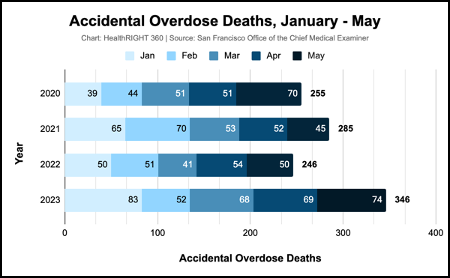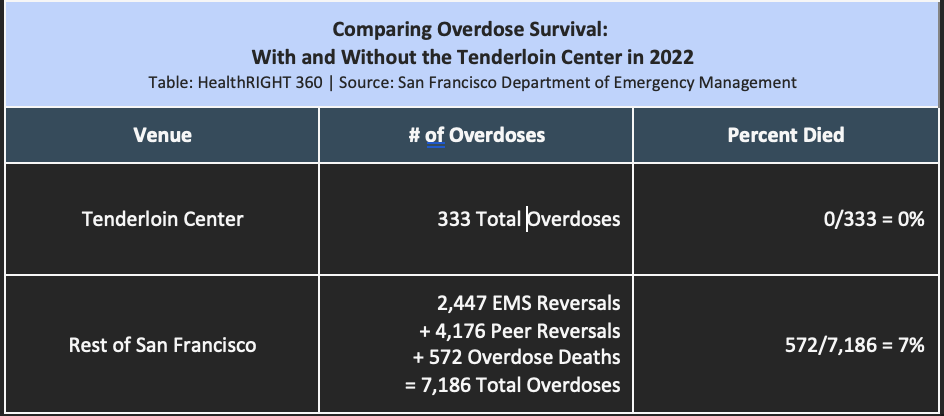San Francisco, CA — The Office of the Chief Medical Examiner has released their Report on Accidental Overdose Deaths for the first five months of 2023. The preliminary number of accidental overdose deaths in May is 74, which brings the total for the year up to 346 — 100 more than the 246 that occurred by this same time last year.[1] This is the worst May on record, surpassing the 70 accidental overdose deaths recorded in May 2020.
Figure 1. Accidental Overdose Deaths, January – May

Record 346 people have died of accidental overdose in San Francisco from January through May 2023
San Francisco is far outpacing its overdose mortality rates seen in previous years. Noticeable in the data is the dip in accidental overdose deaths in 2022, when the Tenderloin Center (TLC) was operational. Several factors may explain the decrease in accidental overdose deaths in 2022 and the subsequent increase this year. These factors include the closure of the Center – which offered overdose prevention services – and an escalation in punitive approaches, including the further criminalization of drug use and arrests of people who use drugs.
Based on the San Francisco Department of Emergency Management’s overdose reversal data, during the time that the TLC was open – January 18, 2022, through December 4, 2022 – an estimated 572 of the 7,186 overdoses in the rest of San Francisco (seven percent) led to death, whereas none of the 333 overdoses that occurred at TLC led to death.[2] Though the datasets for the rest of San Francisco are still incomplete, Figure 2 (below) reflects the preliminary findings that were released by RTI International late last year.[3]
Figure 2. Comparing Overdose Survival: With and Without the Tenderloin Center in 2022

The Tenderloin Center, part of San Francisco’s Tenderloin Emergency Initiative, helped to reduce overdose deaths.
The Center, which was located at United Nations Plaza, served over 400 people per day; however, it was closed without replacement services.[4][5] Since this closure, and lack of continuity of care, San Francisco officials have been “aggressive” about increasing enforcement and arrests of people who use drugs, implementing coerced treatment, and reducing diversion opportunities.[6][7][8][9] These tactics are known to exacerbate overdose deaths. A recent study in the American Journal of Public Health revealed that police seizure of any amount of opioid drugs led to a twofold increase in overdoses in the surrounding area for up to three weeks.[10]
Coercive treatment not only fails to help but also poses a significant danger when individuals reintegrate into the community and resume substance use, which often happens with untreated substance use disorders. Fatal overdose risk is twice as high after involuntary treatment or civil commitment compared to voluntary treatment. It is crucial to emphasize that ineffective forced treatment in carceral settings ultimately raises the risk of overdose death. Coerced treatment is also likely to disproportionately affect low-income communities and people of color, which furthers disparate racial outcomes because the rate of fatal overdose is 120 times higher among people recently released from correctional settings.[11]
Despite an increase in client intakes for withdrawal management and residential substance use disorder treatment programs, San Francisco lacks a comprehensive set of evidence-based solutions to address the overdose crisis on a larger scale. Effective service delivery is further complicated by challenges in worker recruitment and retention, which could be mitigated through improved contracts that offer competitive wages and account for historic underfunding and inflation.
To implement a comprehensive continuum of care grounded in public health, we recommend expanding non-discriminatory access to medication for addiction treatment (MAT), fact-based drug education, funding for peer-led programs and tenant-led overdose navigation in supportive housing, scaling up drug sobering centers and drug adulterant testing, supporting and resourcing syringe services programs, and implementing harm reduction interventions such as overdose prevention centers and safer supply.
About HealthRIGHT 360:
HealthRIGHT 360 is a non-profit provider of substance use disorder treatment, mental health services, and primary care to over 47,000 Californians annually, including more than 15,000 San Franciscans. HealthRIGHT 360 provides care that is compassionate, non-judgmental, and evidence-based. We provide services, regardless of one’s ability to pay; inspired by our belief that healthcare is a right, not a privilege. Learn more about HealthRIGHT 360 and our programs at https://www.healthright360.org/.
[1] Rodda, L. “Accidental Overdose Report, Jan 2023 – May 2023,” OCME Accidental Overdose Reports, Office of the Chief Medical Examiner, June 15, 2023. https://sf.gov/resource/2020/ocme-accidental-overdose-reports
[2] “Reducing fatal and non-fatal overdoses in the Tenderloin,” Department of Emergency Management, City and County of San Francisco, June 8, 2023. https://sf.gov/data/reducing-fatal-and-non-fatal-overdoses-tenderloin
[3] Kral, A. “Tenderloin Center (TLC) Preliminary Evaluation Findings,” RTI International, November 15, 2022. https://sfstandard.com/wp-content/uploads/2022/11/TLC-evaluation-presentation-Alex-Kral-111422.cleaned-1-1.pdf
[4] Moench, M. “Here’s what new research on Mayor Breed’s Tenderloin Center found about its impact,” San Francisco Chronicle, November 16, 2022. https://www.sfchronicle.com/bayarea/article/breed-tenderloin-center-sf-17588199.php
[5] Moench, M. “Mayor Breed’s Tenderloin Center just closed. What does that mean for S.F.’s ongoing drug epidemic?,” San Francisco Chronicle, December 5, 2022. https://www.sfchronicle.com/sf/article/Mayor-Breed-Tenderloin-Center-17631151.php
[6] Moench, M. “S.F. police crack down on public drug use ahead of Mayor Breed’s command center targeting dealers,” San Francisco Chronicle, June 2, 2023. https://www.sfchronicle.com/sf/article/sf-drug-dealing-tenderloin-emergency-center-18132343.php
[7] Leonard, C. “‘Enormous rise’ in San Francisco overdose deaths in 2023,” San Francisco Chronicle, April 19, 2023. https://www.sfchronicle.com/sf/article/drug-overdose-deaths-2023-17904060.php
[8] Moench, M. “S.F. arrests 58 drug users in a week as Breed cracks down. Sheriff targets open-air markets, usage,” San Francisco Chronicle, June 8, 2023. https://www.sfchronicle.com/sf/article/sf-mayor-breed-drug-crackdown-sheriff-18140952.php
[9] Neilson, S. “Brooke Jenkins has transformed San Francisco’s crime policies. Here’s what the data shows,” San Francisco Chronicle, March 29, 2023. https://www.sfchronicle.com/bayarea/article/san-francisco-arrests-jail-17837526.php
[10] Carroll, J., del Pozo, B., Ray, B., Hedden, B., Huynh, P., Korzeniewski, S., Mohler, G., and Victor, G. “Spatiotemporal Analysis Exploring the Effect of Law Enforcement Drug Market Disruptions on Overdose, Indianapolis, Indiana, 2020–2021,” American Journal of Public Health, June 7, 2023. https://ajph.aphapublications.org/doi/full/10.2105/AJPH.2023.307291
[11] “An Assessment of Fatal and Nonfatal Opioid Overdoses in Massachusetts (2011-2015),” Massachusetts Department of Public Health, August 16, 2017. https://www.mass.gov/doc/legislative-report-chapter-55-opioid-overdose-study-august-2017/download
